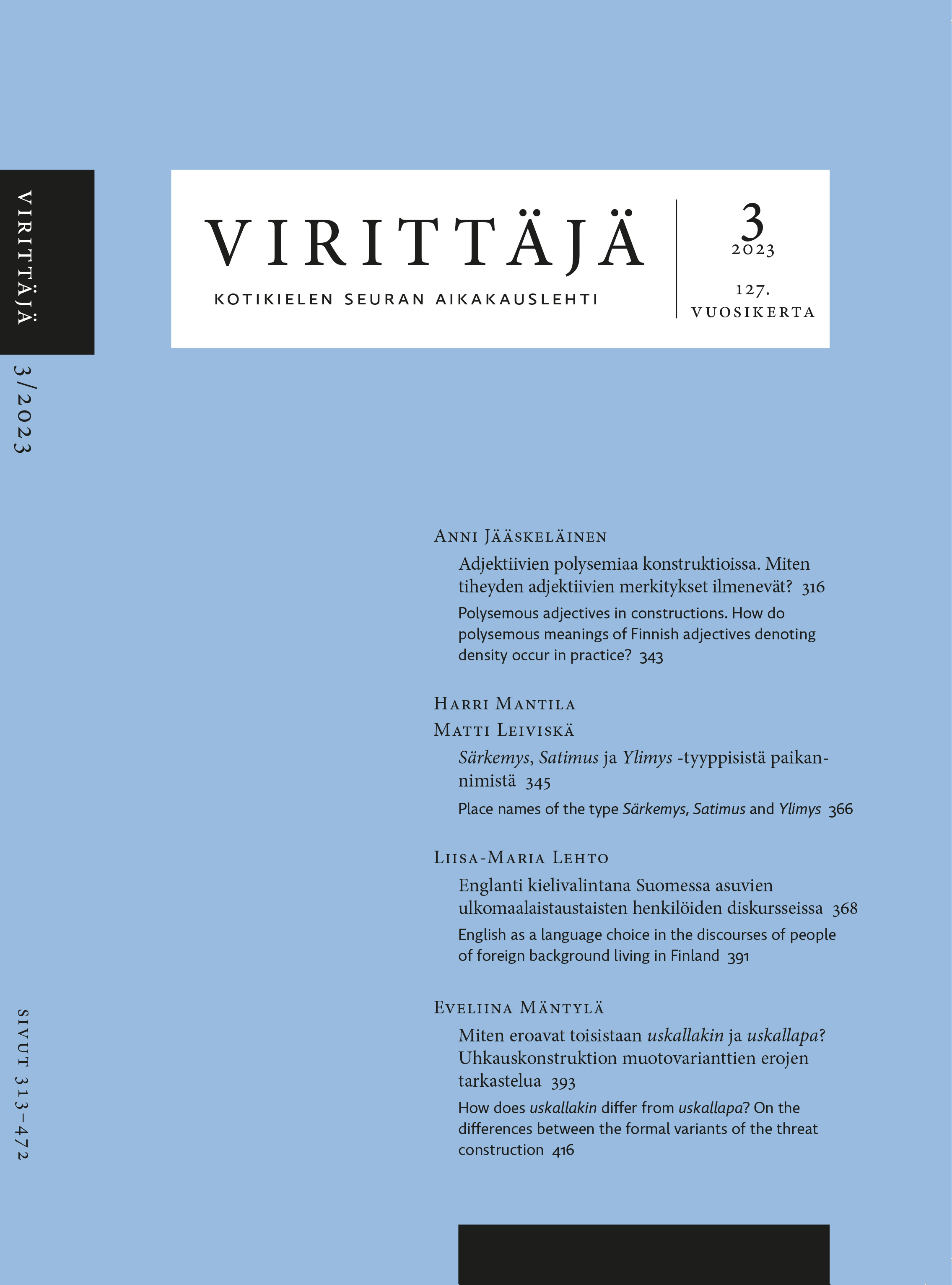Miten eroavat toisistaan uskallakin ja uskallapa?
Uhkauskonstruktion muotovarianttien erojen tarkastelua
Abstrakti
Artikkeli käsittelee uhkauskonstruktiota eli rakennetta, jossa uskaltaa-verbin 2. persoonan imperatiivimuodon ja liitepartikkelin yhdistelmä aloittaa uhkaa implikoivan ja epätoivottavaa toimintaa kuvaavan ilmauksen (esim. Uskallakin koskaan irvailla minulle tuollaisesta asiasta; Uskallapa tässä diktatuurissa yrittää, jos olet työtön. Yrittelet ilman tuloa mistään). Uhkauskonstruktion toteutumat voivat poiketa toisistaan niin muodoltaan kuin käytöltään. Artikkelissa selvitetään, onko liitepartikkelin variaatio kytköksissä konstruktion toteutumien erilaisiin käyttötapoihin. Suomi24-kopuksesta kootun, yhteensä 294 imperatiivimuotoisen uskaltaa-verbin ja liitepartikkelin yhdistelmän tarkastelu pohjautuu konstruktiokielioppiin ja kognitiiviseen kielioppiin.
Epätoivottavaa toimintaa kuvaavat yhdistelmät eli uhkauskonstruktion toteutumat jaetaan artikkelissa käyttönsä perusteella kahdenlaisiin tapauksiin, jotka edustavat konstruktion alavariantteja. Tapauksissa, joissa puhuja sitoutuu uhkaukseen, uhan lähde ja uhan kohde ovat spesifejä, useimmiten keskustelutilanteen puhuja ja kuulija. Sen sijaan tapauksissa, joissa puhuja ei sitoudu uhkaukseen, epäspesifit uhan lähde ja uhan kohde on ilmaistu implisiittisesti ja myös puhuja voi olla uhan kohde. Jako perustuu näin pääasiassa asiaintilan konstruoinnin objektiivisuuden tarkasteluun.
Kaikki aineiston imperatiivimuotisen uskaltaa-verbin ja liitepartikkelin yhdistelmät kuvaavat useimmiten epätoivottavaa toimintaa, ja näistä tapauksista suurimmassa osassa puhuja sitoutuu uhkaukseen. Eri liitepartikkelillisten toteutumien suhde uhkauskonstruktion prototyyppiin kuitenkin vaihtelee. Partikkelien -kin ja -s käyttö painottuu tapauksiin, joissa puhuja sitoutuu uhkaukseen, kun taas -pA ja -pAs ovat lähes yhtä yleisiä tapauksissa, joissa puhuja ei sitoudu uhkaukseen, kuin tapauksissa, joissa puhuja sitoutuu uhkaukseen. Partikkeli -hAn on aineistossa harvinainen, ja se edustaa yhtä usein molempien alavarianttien toteutumia. Vaikka pAs-partikkelillinen variantti on tapausmääriltään kaikkein yleisin, kin-partikkelillinen muotovariantti edustaa kaikista säännönmukaisimmin uhkauskonstruktion prototyyppiä. Koska liitepartikkelien kuvaukset aikaisemmissa tutkimuksissa ovat linjassa sen kanssa, minkälaisiin uhkauskonstruktion toteutumiin liitepartikkelien käytöt painottuvat, liitepartikkelin muutoksen voi katsoa olevan yhteydessä merkityksen muuttumiseen.
How does uskallakin differ from uskallapa? On the differences between the formal variants of the threat construction
The article discusses the undesired action describing threat construction that consists of a grammatically positive second-person imperative-form of the verb uskaltaa and a clitic particle (e.g. Uskallakin irvailla minulle tuollaisesta asiasta. ‘Don’t you dare make fun of me for something like that.’ / Uskallapa tässä diktatuurissa yrittää. Yrität ilman tuloa mistään ‘Don’t you dare even try in this dictatorship. You’re trying without getting paid’). The occurrences of the threat construction can differ from each other in terms of their form (e.g. they may use a different clitic particle) and function (directive / affective statement). This article aims to establish whether the variation of the clitic particle bears a connection to these different functions. The theoretical and methodological framework of the study lies in cognitive construction grammar and cognitive grammar, while also incorporating some aspects of conversation analysis. The findings are based on a body of data consisting of 294 combinations of the verb uskaltaa and a clitic particle, all collected from the Suomi24 corpus.
The writer has divided the occurrences of the threat construction into two groups that represent distinct subvariants: cases where the speaker commits to the threat and cases where the speaker does not commit to the threat. The analysis is essentially based on the objective and subjective construal of the source and the target of the threat. When the speaker commits to the threat, the source of the threat is specified and explicitly expressed (usually by the speaker), as is the target of the threat (usually the hearer). On the other hand, when the speaker does not commit to the threat the source and the target of the threat are unspecified and implicitly expressed.
According to these findings, the uses of -kin and -s are centred in cases in which the speaker commits to the threat, whereas -pA and -pAs exist more often in cases in which the speaker does not commit to the threat. The particle -hAn is rare in the data, and it occurs both in the cases in which the speaker commits to the threat and the cases in which the speaker does not commit to the threat. When examining all the data, the analysis shows that most combinations of imperative-form uskaltaa and a clitic particle express undesired action, and in most of these cases the speaker commits to the threat. This means that the variant with -kin most often represents this prototype even though the variant with -pAs is the most frequent of all threat construction formal variants. Since descriptions of the clitic particles in previous studies agree with findings regarding the clitic particles’ tendency to centre different threats in different threat-construction subvariants, the variation of the particle can be linked to a change in meaning.






